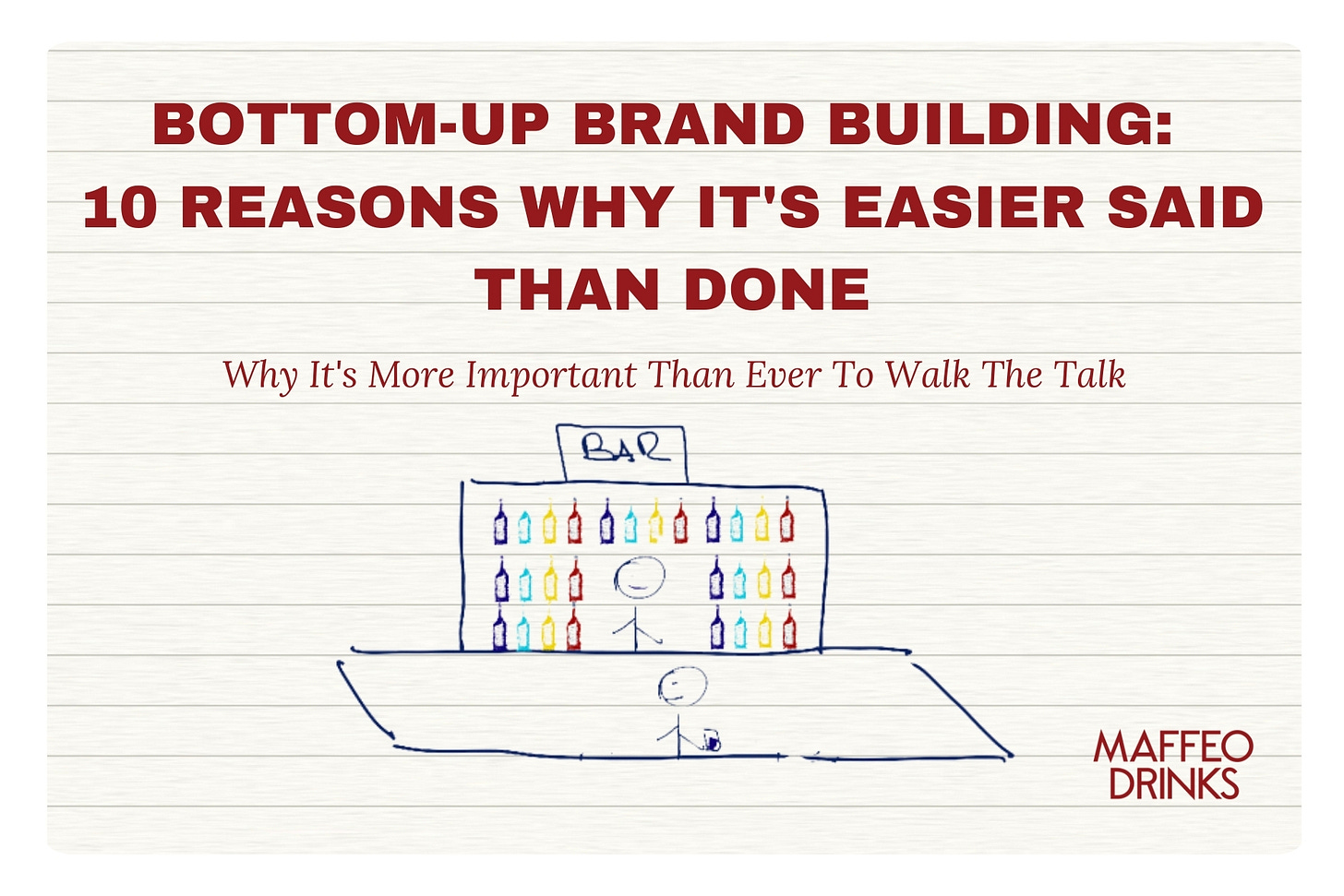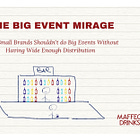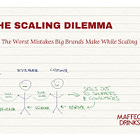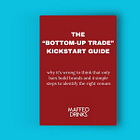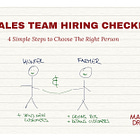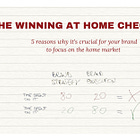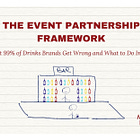Bottom-Up Brand Building: 10 Reasons Why It's Easier Said Than Done
Why It's More Important Than Ever To Walk The Talk
The MAFFEO DRINKS Guides is a bi-weekly email newsletter. With a systematized approach, it helps drink builders grow their brand from 10 to 10k cases. Each edition solves one clear challenge for subscribers. Some editions are free, and others are paid. Sign up here
Dear Bottom-up Drinks Builder,
In today's issue, we're tackling a paradox that plagues many in our industry: Why is bottom-up brand building so widely understood yet so challenging to implement?
Have you ever felt frustrated that despite understanding the bottom-up approach, you're struggling to make it work? You're not alone.
Implementing a bottom-up strategy in the beverage industry can feel like trying to solve a Rubik's cube blindfolded.
It's frustrating. You know the bottom-up approach is powerful, but you can't make it work in practice. You're left wondering: Why is this so hard? Am I doing something wrong? How do others make it look so easy?
Understanding the bottom-up approach is just the first step. Implementing it effectively requires navigating complex challenges that many aren't prepared for.
First, building a brand takes time so you won't find any silver bullets here. It's about creating a system that respects the industry's complexities and overcomes common implementation hurdles.
Bottom-up brand building isn't just a strategy; it's a mindset shift that involves various stakeholders at different levels of your organization and the industry.
Without understanding these challenges, you'll waste time and resources trying to implement a strategy that looks great on paper but fails in practice.
But what if there was a better way? A method that doesn't just explain the theory but gives you practical tools to overcome implementation challenges?
Unfortunately, most brands focus solely on either:
pushing the bottom-up approach without a systematized approach
or giving up too quickly when faced with implementation difficulties
Let's face it: The struggle is real. Here are the 10 key challenges that make bottom-up brand building easier said than done:
Short-term Pressure vs. Long-term Vision: While brand building takes time, stakeholders often demand quick results. This tension can derail long-term strategies in favor of short-term gains.
Resource Intensity: Bottom-up approaches require significant time, manpower, and financial resources. The personal connections and grassroots efforts needed can strain limited budgets and teams.
Scalability Concerns: Success in one market doesn't guarantee success in another. The fear of not being able to replicate local triumphs on a larger scale can be paralyzing.
Measurement Difficulties: Traditional metrics often fail to capture the actual value of bottom-up growth. How do you quantify bartender relationships or word-of-mouth buzz?
Patience and Persistence in Uncertainty: Bottom-up growth doesn't follow a predictable trajectory. This uncertainty can be uncomfortable for traditional business mindsets accustomed to linear projections. Maintaining motivation and consistency is challenging when results aren't immediate. When progress seems slow, it's tempting to pivot to quicker strategies.
Resistance to Change: Established organizations often struggle to shift from top-down to bottom-up approaches. Overcoming internal resistance can be as challenging as external market factors.
On-Trade or Bottom-up Trade: Finding the right balance between on-trade focus (bars, restaurants) and off-trade efforts (retail) is complex. Neglecting one for the other can lead to missed opportunities. That’s why the Bottom-up Trade, the outlets where you can ultimately build brand foundations, is so important.
Lack of Specialized Expertise: Many teams are built for traditional marketing, not the nuanced, relationship-based approach required for bottom-up growth. This gap can hinder effective implementation.
Finding team members with the right mix of industry knowledge, relationship-building skills, and strategic thinking is problematic. This expertise gap can slow implementation.
The bottom-up part is often left to one or two people who “understand it,” and know-how is lost forever when they leave the company.
Fear of Missed Opportunities: The focused nature of bottom-up building can make brands feel they're missing out on broader opportunities. This fear can lead to premature expansion or diluted efforts.
Think about those pallets sent left and right that are still collecting dust in some importer's warehouses (or, even worse, are sold at a discount).
Inconsistent Execution: Maintaining the same level of attention and quality across all touchpoints over time is demanding. Inconsistency can undermine the trust and relationships built.
These challenges can make bottom-up brand building feel like an uphill battle. You might be wondering: How do successful brands overcome these hurdles? What strategies can turn these challenges into opportunities?
Despite these difficulties, it's crucial to understand that bottom-up brand building isn't just an option – it's the only viable path forward in today's market.
The top-down approaches that worked decades ago are no longer effective in our hyper-connected, consumer-driven world. Consumers are savvier, competition is fiercer, and authenticity is paramount.
Bottom-up building allows brands to create genuine connections, adapt to local preferences, and build a loyal following that can withstand market fluctuations. Yes, it's challenging, but also the most rewarding and sustainable way to create a lasting brand.
The good news is that there are proven methods to address each of these challenges and implement a successful bottom-up strategy. But the solution isn't one-size-fits-all. It requires a tailored approach based on your brand's unique position and goals.
In my years of experience, I've developed a method that focuses on three critical stages of demand:
Creating Demand: Where we spark initial interest and curiosity in your brand.
Converting Demand: Where we turn that interest into actual sales and placements.
Sustaining Demand: Where we ensure long-term loyalty and consistent reorders.
This approach is designed to work across all levels of brand growth, whether you're aiming for:
The One Bottle Stage, when a team is of only a handful of people
The One Case Stage, when you start engaging with third parties such as importers and wholesalers
The One Pallet Stage as you expand nationally through key accounts
Each demand stage requires unique strategies to overcome the 10 challenges we've discussed. Understanding where your brand is in this journey allows us to apply targeted approaches to propel you to the next level.
Are you struggling with any of these challenges? Which stage of demand is your brand currently focusing on? I'd love to hear about your experiences and discuss strategies specific to your brand's current stage and goals.
Let's connect and explore how we can turn these obstacles into stepping stones for your brand's success.
Reply to this email or schedule a call, and let's start building your brand from the bottom up – the right way.
Remember, brands are built bottom-up, but implementation is critical!
I hope this mini-guide will help you develop the small, consistent habits you need to build your brand from the ground up.
If you liked it, share it with your friends and team members who need to hear it today!
Whenever you're ready, there are more ways I can help you:
Listen to my Podcast Listened to by Drinks Builders from 111 countries. Every week, a new episode featuring Drinks Builders from around the Globe sharing their learning building Bottom-up.
Download my Digital Course: Dead-Simple Strategies to Avoid 28 Costly Mistakes (A 40 minutes Self-paced Course)





